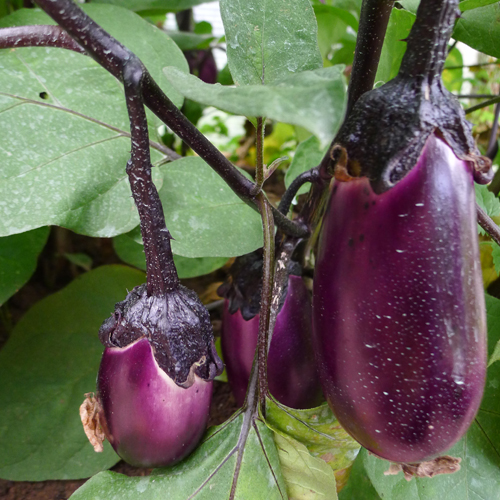Eggplant variety Vera
Everyone's favorite eggplant is a versatile and healthy vegetable. There are many varieties, but not all can be grown in cold climates. Domestic breeders have bred a variety that is not afraid of cold snaps and bears the tender name Vera. The registration date of the application is 1998, and our hero was included in the State Register in 2001. For cultivation, not southern regions are recommended, but regions with a harsh climate - the Ural, West Siberian, Far Eastern. Suitable for garden plots, home gardens and small farms.

Description
Plants can be compact - 73 - 75 cm or tall - up to 105 cm. Leafiness is medium. The leaf is medium-sized, green-purple in color. The surface is slightly rough, the edges of the plate are notched. The flower cup is studded with rare thorns. The fruits of the Vera eggplant are very attractive in appearance. They are pear-shaped, not too large - up to 20 cm in length, average weight 125 - 181 g, maximum weight - 300 g. The skin is glossy, shiny, smooth, purple in color. The pulp is dense, without voids, whitish color, does not contain bitterness. The taste is excellent.
Characteristics
- The variety is early maturing - 110 - 118 days pass from the germination period to harvesting. Technical ripeness occurs in August or September;
- one of the clear advantages is resistance to cold weather, which makes it possible to obtain crops in areas of risky farming;
- pleases with a stable yield. The average indicator is 0.9 - 1.2 kg per square meter, the maximum is 2.9 kg / m2;
- the output of marketable products is high - from 90 to 100%;
- the way of use is universal. The fruits are fried, stewed, made from them various snacks and side dishes, harvested for the winter.
Features of agricultural technology
You can grow in two ways - seed and seedlings. The first is well suited for regions with early and warm spring. Seeds are sown in the second half of April - early May. Sowing depth - 1.5 - 2 cm. The second method is for areas with short summers. Seedlings are sown for seedlings in late February - early March. Thanks to this method, Vera has time to bring the crop before the onset of frost. In order not to risk the harvest in a harsh climate, many gardeners grow eggplant in a warm garden bed. In it, the soil warms up quite quickly, and, if necessary, it is easy to put a shelter on the box.
The planting pattern, taking into account the height, is 30 - 35 cm between plants in a row and 60 - 65 cm between rows. The ovaries need to be normalized. You can leave no more than 10 pieces on the bush.
Growing a culture is easy. Make sure the soil is moderately moist. You also need to carry out periodic weeding and loosening. During the growing season, the variety consumes quite a lot of nutrients, so it should be planted in pre-fertilized soils, and during cultivation, give preference to organic fertilizing. In total, during the season there should be 3 - 4 fertilizers, but not more. Preventive spraying will help avoid serious problems with diseases and pests.
Advantages and disadvantages
Eggplant Vera is ideal for small areas where it will not be difficult to care for an unpretentious crop. Stable fruiting and good productivity will allow not only to eat a valuable product in the season of consumption, but also to prepare it for the winter. A big plus, of course, is resistance to cold weather, which allows you to grow a thermophilic plant in adverse climatic conditions.
But culture also has a small flaw. Its yield is not high enough for industrial use.








